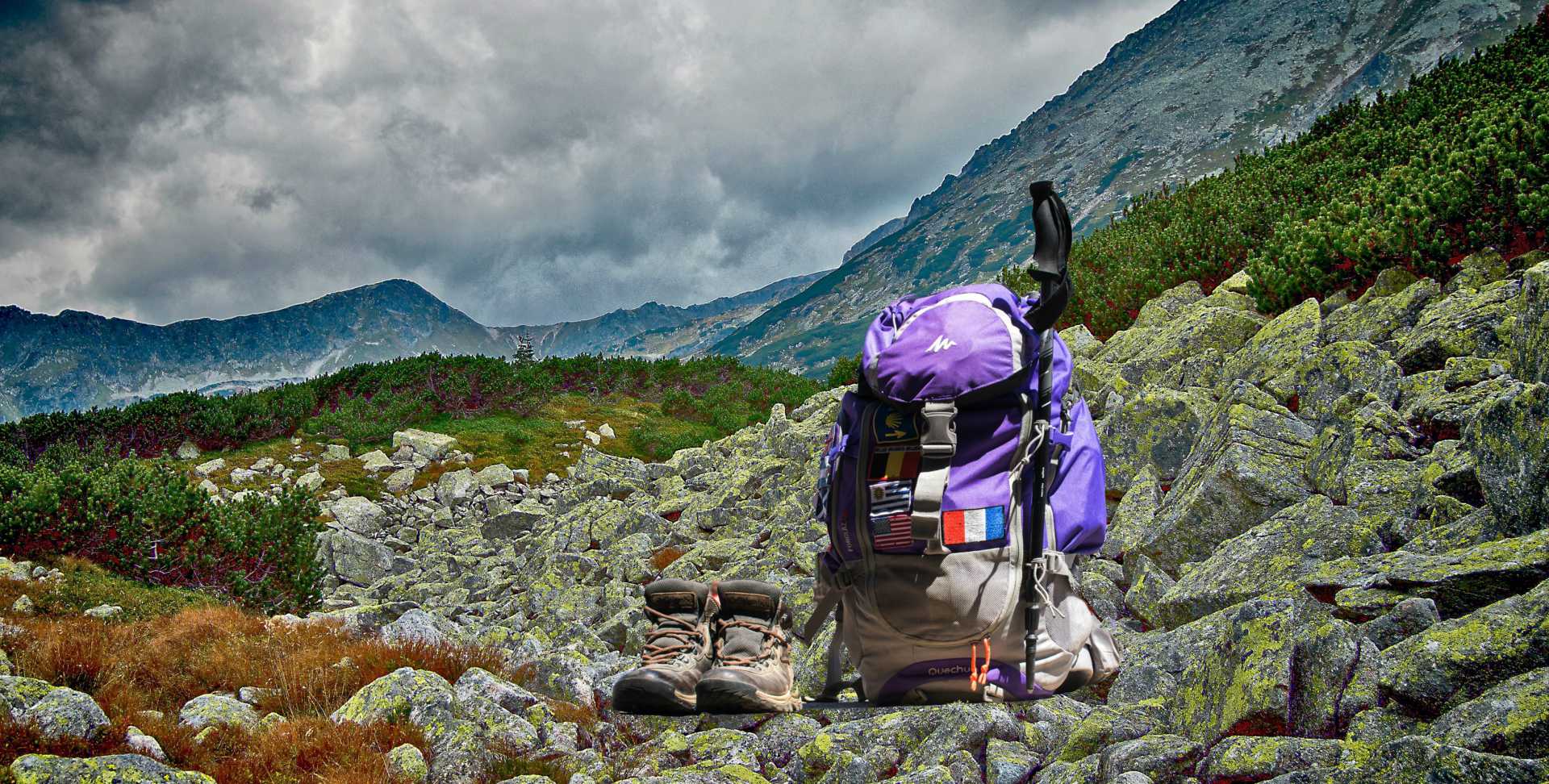Walking Gear Checklist
Having the right outdoor clothing and equipment can make a big difference to your enjoyment and safety.
Walking in Continental Europe is very popular, and rightly so. It is one of the best ways to appreciate nature, it’s healthy and it’s also a great way to relax. However, there is an element of risk inherent in hill-, mountain- and even countryside walking, but if you understand the risks and take some basic safe walking precautions you’re unlikely to have any problems.
Most hazards can be avoided by using good old-fashioned common sense.
We’ve compiled a list of the most useful walking gear and outdoor clothing to pack in your kit. Please note that not all of these items may be applicable, depending on the climate, length and terrain of your upcoming walks.
Therefore, the following list is neither prescriptive nor exhaustive, but should serve as a useful guide to ensure you don’t forget to pack a critical item for your walking holiday.
Walking Boots: One of the most important pieces of outdoor wear you’ll ever purchase for your walks is a good-quality pair of hiking boots. You do not want to skimp when picking out footwear, as the wrong pair of shoes or walking boots can cause blisters, discomfort, sprains or even more serious injuries.
What you wear on your feet depends on the types and lengths of walks and the time of year you plan on hiking. Will you be doing mainly short hikes or longer distances, carrying a heavy backpack? Will you be walking on relatively smooth ground or trekking rougher, more varied terrain with steep ascents and rocky scrambles? Will you be walking mostly during the summer or all year round, rain or shine? These are the questions you should be asking yourself when choosing walking boots. For example, generally low-cut, flexible walking shoes, that look similar to runners, are geared towards shorter more leisurely trails; whilst higher-cut boots with stiffer mid soles and ankle support are geared towards longer walks on rougher terrain.
Whether you are buying walking footwear in person in an outdoor store or ordering them online, talk to one of the shop’s sales staff, telling them about your walking plans and asking any questions you may have. If you buy your boots online, then make sure that there is a reasonable return policy – just in case you realise that they are not the perfect fit when you receive them. When trying on walking boots, check to make sure your feet sit comfortably with proper ankle and arch support. As you walk, your foot and ankle should be held firmly in place (with no sliding back and forth), but you should still be able to wiggle your toes. Also, your toes should not be touching the inner front of the boots. Always try on hiking boots near the end of the day, when your feet are at their largest. Wear the same socks you’d wear to go walking. If you expect to wear a range of socks – say, thin socks for summer hiking and thicker socks for winter walking – try the boots on with both. Walk uphill and downhill. If the boots fit right, your feet will stay securely positioned; if they don’t fit right, your heels will move around in the boot as you walk uphill, and your toes will slide forward against the front of your boot as you go downhill.
Hiking Socks / Trekking Socks: Ideally, you should have socks that are especially made for walking / trekking —those that provide cushioning and wick moisture away from your feet.
Base and Mid Layers: For base layers (closest to your skin), wear synthetic tee-shirts or long-sleeved thermal shirts as well as synthetic shorts or trousers (or two-in-one zip-off trousers). Cotton shirts and jeans are not recommended! Just in case you get cold, pack a fleece (since it dries quickly, is lightweight and is easy to pack) or a jumper for your mid layers.
Waterproofs (Jacket and Over-trousers): Weather in the mountains can be unpredictable, especially in the Alps, so dress in layers and bring waterproof clothing – a jacket and pair of over-trousers – to ensure you’re prepared for all eventualities. Look for an outdoor jacket made of a waterproof / windproof and breathable material such as Gore-Tex, perhaps with a mesh inner lining, so that you can keep moisture out and warmth in. For high alpine hiking, 3-layer Gore-Tex jackets with a draw-string hood are best. Soft shell jackets, which you can wear over a fleece mid layer, are handily compressible, so you can easily stow them away in your backpack if the weather is fine. For extreme cold conditions (i.e. for winter and high alpine trekking), you may need to invest in a down or synthetic-insulated jacket.
Hat and Gloves: You need to keep your head and hands warm with a snug hat and gloves. Windstopper gloves are ideal as they provide insulation while blocking the wind, and often come with grip pads to allow for finger dexterity. There are also windstopper hats to protect your head from vicious wind chill. Don’t be fooled: even during the warmer seasons your body can get quite cold; especially when walking at higher altitudes or when it suddenly gets cold, wet or windy.
For Hot, Sunny Days: When the sun is shining, make sure you never leave home without a sun hat to protect your entire face as well as your neck. You should also bring sunglasses, sunscreen and sun protection lip balm. As ultraviolet (UV) radiation levels are higher in alpine regions when compared with sea level, all exposed areas of skin should be covered in water-resistant, broad-spectrum SPF 30+ sunscreen (broad-spectrum means it protects against UVA and UVB rays). Keep in mind that UV is also reflected by snow and glacier ice. Apply sunscreen and protective lip balm about 20 minutes before going outside and re-apply every two hours.
H20: Sufficient fluid intake is essential on any walk or hike, no matter how short. When we exercise, our body temperature is controlled by the evaporation of sweat from the body’s surface. If your body is dehydrated, then heat can’t be dissipated in this way. This can result in the rapid onset of heat exhaustion. Water is probably the best option, but for longer days you may want to include drinks that contain electrolytes, which will be helpful in maintaining your sodium levels. Water needs depend on the individual, but as a very general rule of thumb an adult needs at least 2 litres for a 5-hour walk. But in general it’s best to assume that you’ll need more than you think you’ll need! If you are going on a short walk you can use a lightweight water bottle. For hands-free drinking (and to carry a higher volume of water) use a hydration bag with a tube attached (such as a Platypus pack) that you can carry in your rucksack. It’s also a good idea to carry extra water in your car so you can drink from that supply before and after the hike. Find out ahead of time where you can replenish your water supply; sources may come from public utilities, mountain huts or from nature’s bounty, for which you should pack a water filter or water disinfectant.
Food: Bring enough food for the day and some extra energy giving supplies, such as cereal bars or dried fruit and nuts. Optional is a hot drink in a refillable flask. Probably the most effective way to consume food when walking is to eat ‘little but often’ throughout the day. It’s also vital that your day begins with a good breakfast, eaten ideally about an hour before you start walking.
For Emergencies: Bring a whistle and a head torch or hand-held torch including spare batteries. You will probably be carrying a mobile phone, but be aware that you should not rely on it for communications during emergency situations as mobile phone coverage can be limited in the hills and alpine regions of Europe.
First aid kit: A walker’s basic first aid kit should include plasters of various sizes (and special blister plasters are recommended as well!), antiseptic cream and wipes, cotton wool, sterile pads, gauze, tape, bandage, scissors, safety pins, pain relief (e.g. paracetamol), tweezers and a small thermal blanket – all held in a soft pouch or carry case.
Walking Maps: Even if you are familiar with your route and have walked it previously, you should always take a map with you. Plans may be forced to unexpectedly change, perhaps due to a path closure, an injury or adverse weather conditions requiring a shorter, more straight-forward route back. In these cases a map will become your greatest ally. Simple trail maps are readily available from local tourist offices and national park centres—usually for free or for a nominal fee. However, with the exception of short rambles, you should always carry a full walking map as well (and a waterproof case to protect it from precipitation). If you need help in identifying the best maps for your chosen destination, then please take a look at the links to our Amazon stores, highlighted on the right hand side of every regional page on our website.
Walking Poles / Trekking Poles: First of all, walking and trekking poles are the same thing – people just use different names for them. Walking poles are used to give support and propulsion by allowing your arms to do some of the work, but you will also benefit from less strain on your knees when walking downhill. Choose telescopic, light weight (i.e. aluminium) poles that feature shock absorber technology and come with moulded handles and wrist straps. Setting your poles to the right length is the first step in using trekking poles effectively. When your walking poles are set at the correct height for you and you are holding the handle of the pole with the tip on the ground, your elbow should be bent at about 90 degrees.
Rucksack / Daypack: Although you do not want to leave any necessary equipment behind, you do not want to overload your back with an excruciating weight either. For day walks, a small backpack (i.e. 25 to 35 litres in size) should suffice. You’ll be wearing your rucksack a lot, so be sure to find one which is really comfortable, as well as having the right capacity. The shoulder straps should be extra wide and padded, so that the rucksack can fit close to the body and without digging in. Also take care to check the quality of material and the seams. Rucksacks are sorted according to their volume of space available inside a pack. This is expressed in litres, and is often indicated in a pack’s name. So what volume is right for you?
Spare Clothes: Bring a minimum of one additional thermal shirt or fleece. For longer walks, you should also pack spare gloves, a spare hat and an additional pair of socks.
Optional Extras: Other items which you may find useful for your upcoming walking trip include:
- Personal medication (e.g. inhaler)
- Pen and Notepad
- Swiss Army Knife or Knife multi-tool
- Compass (if you know how to use it)
- GPS to record the route
- Insect repellent
- Gaiters
- Sit mat
- Camera
- Guidebook of the local area
- Survival bag (emergency shelter providing wind and rain protection for a small group – should you be forced to stop during bad weather).

